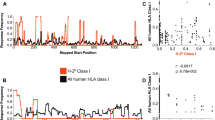Abstract
DISTINCT T-cell subsets recognise antigens in association with different major histocompatibility complex (MHC) products, and this provides a means of identifying the subsets which operate in protective immunity against pathogens. Thus, cytotoxic T cells (Tc) recognise antigen in association with products of the K and D regions of the H–2 complex of the mouse; and because protection against lymphocytic choriomeningitis1, ectromelia2 and influenza3 requires compatibility at K or D in adoptive transfer experiments, it follows that the subset mediates protective immunity against these viruses. I-region compatibility requirements have not hitherto been observed in viral infections, but are necessary for protection against the intracellular parasite Listeria monocytogenes. This suggests that T helper cells (TH) and/or the lymphocytes responsible for delayed hypersensitivity and lymphokine release may be involved4 (these lymphocytes can provisionally be included within the TH subset). Adoptive transfer studies in mice have clearly established a major role for T lymphocytes in recovery from infection with herpes simplex virus (HSV-1)5–7. The T-lymphocyte subclass or classes responsible for this protection are not known. In vitro cytotoxic T cells (Tc)8, and their primed precursors9 can be obtained from HSV-1 infected mice. The present study indicates that immune protection against HSV-1 can be conferred by immune spleen cells possessing either I or K-D compatibility, and that long-lasting protection is conferred only by cells with I-region compatibility.
This is a preview of subscription content, access via your institution
Access options
Subscribe to this journal
Receive 51 print issues and online access
$199.00 per year
only $3.90 per issue
Buy this article
- Purchase on Springer Link
- Instant access to full article PDF
Prices may be subject to local taxes which are calculated during checkout
Similar content being viewed by others
References
Zinkernagel, R. M. & Welsh, R. M. J. Immun. 117, 1495–1502 (1976).
Blanden, R. V., Bowern, N. A., Pang, T. E., Gardner, I. D. & Parish, C. R. Aust. J. exp. Biol. med. Sci. 53, 187–195 (1975).
Yap, K. L., Ada, G. L. & McKenzie, I. F. C. Nature 273, 238–239 (1978).
Zinkernagel, R. M. et al. J. exp. Med. 145, 1353–1367 (1977).
Ennis, F. A. J. infect. Dis. 127, 632–638 (1973).
Oakes, J. E., Infect. Immun. 12, 166–172 (1975).
Rager-Zisman, B. & Allison, A. C. J. Immun. 116, 35–41 (1976).
Sethi, K. K. & Brandis, H. Z. Immun Forsch. exp. Ther. 153, 162–173 (1977).
Pfizenmaier, K., Starzinski-Powitz, A., Rollinghoff, M., Falke, D. & Wagner, H. Nature 265, 630–632 (1977).
Lopez, C. Nature 258, 152–153 (1975).
Pang, T., McKenzie, I. F. C. & Blanden, R. V. Cell Immun. 26, 153–159 (1976).
Zisman, B., Hirsch, M. S. & Allison, A. C. J. Immun. 104, 1155–1159 (1970).
Hirsch, M. S., Zisman, B. & Allison, A. C. J. Immun. 104, 1160–1165 (1970).
Burns, W. H., Billups, L. C. & Notkins, A. B. Nature 256, 564–566 (1975).
Author information
Authors and Affiliations
Rights and permissions
About this article
Cite this article
HOWES, E., TAYLOR, W., MITCHISON, N. et al. MHC matching shows that at least two T-cell subsets determine resistance to HSV. Nature 277, 67–68 (1979). https://doi.org/10.1038/277067a0
Received:
Accepted:
Issue Date:
DOI: https://doi.org/10.1038/277067a0
This article is cited by
-
Developments in herpes simplex virus vaccines: Old problems and new challenges
Folia Microbiologica (2006)
Comments
By submitting a comment you agree to abide by our Terms and Community Guidelines. If you find something abusive or that does not comply with our terms or guidelines please flag it as inappropriate.



